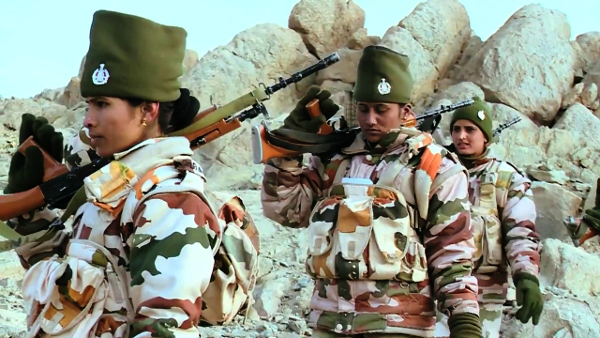On Sunday, twenty members of the India-China LAC guarding Indo-Tibetan Border Police (ITBP) unit were awarded police gallantry medals for their valour during the deadly skirmishes and ongoing military stand-off between the two nations in the eastern Ladakh region in May-June 2020.
During the force’s 60th Raising Day ceremonies, Minister of State for Home Affairs Nityanand Rai pinned medals on the personnel’s chests and presented them with certificates. These medals were announced on the eve of this year’s Independence Day.
As a part of its primary responsibility to guard the 3,488 km-long Line of Actual Control, the central paramilitary is deployed shoulder to shoulder with the Army. According to a force spokesperson, eight servicemen were awarded the Police Medal for Gallantry (PMG) for their courageous conduct, precise preparation, and tactical understanding while defending the country in Galwan Nalla on June 15, last year.
The PMG has been awarded to six men for gallant actions on May 18 in the Finger IV area, while the remaining six have been decorated with the same medal for gallant actions near Hot Springs in Ladakh on the same day, according to the military.
It had claimed that the ITBP troops not only effectively deployed shields to protect themselves in eastern Ladakh but also retaliated vehemently to Chinese PLA advancing troops, bringing the situation under control amid “fierce” face-offs and fights.
They maintained a “determined” stand-off in certain locations for around 17-20 hours over the intervening night of June 15 and 16, 2020, under exceedingly difficult conditions, according to reports. ITBP troops kept PLA troops at bay due to the force’s high-altitude training and survival expertise during frigid Himalayan deployments, and numerous places were safeguarded due to ITBP troops’ all-out and suitable response on several fronts.
During the conflicts, twenty Army personnel were martyred, while China claimed five casualties on their side, a count that is widely thought to be significantly more. Three other ITBP members were also awarded the PMG for their anti-Naxal operations in Chhattisgarh, where they showed daring, tenacity, and determination.
Deputy Inspector General (Veterinary) Sudhakar Natarajan was also awarded the police medal for meritorious service during the event for providing exceptional service in the force’s animal transport wing, which is responsible for ensuring rations and logistics to the force’s mountainous border deployments.
Natarajan is credited for introducing the first batch of Belgian Malinois infantry patrol dogs to the ITBP in 1992, which was followed by the other Central Armed Police Forces (CAPF). In the aftermath of the Chinese aggression, the ITBP, which numbered over 90,000 soldiers, was formed in 1962.
India’s major border patrol organisation for its border with Tibet Autonomous Region is the Indo-Tibetan Border Police (ITBP). It is one of India’s five Central Armed Police Forces, established under the CRPF Act on October 24, 1962, in the aftermath of the Sino-Indian War of 1962.
The “Indo-Tibetan Border Police Force Act, 1992” was enacted by the Indian Parliament in September 1996 to provide for the formation and regulation of the ITBP in order to ensure the security of India’s borders and affairs related to it. Balbir Singh, a police officer who had previously worked for the Intelligence Bureau, was the first Inspector General of the ITBP.
The ITBP, which began with four battalions and was restructured in 1978, has grown to 60 battalions, 15 sectors, and five frontiers as of 2018, with a sanctioned strength of 89,432.
The ITBP patrols the Indo-China border near Nathu La. The force has been trained in civil medical camps, disaster management, and nuclear, biological, and chemical emergencies. ITBP members have served in UN peacekeeping missions in Bosnia and Herzegovina, Kosovo, Sierra Leone, Haiti, Western Sahara, Sudan, Afghanistan, and other places across the world. The ITBP has two battalions assigned to the National Disaster Response Force.
Source:Republic TV
You may also like
-
IAF Aircraft Set Course For Exercise Eastern Bridge VII At Oman
-
IAF Set To Host The Indian Defence Aviation Exposition-II At Jodhpur
-
Defence Secretary to co-chair 5th India-Philippines Joint Defence Cooperation Committee meeting in Manila
-
Simultaneous Launch Of ‘malpe And Mulki’, Fourth And Fifth Ships Of Asw Swc (Csl) Project
-
Aatmanirbharta in Defence: MoD signs Contract with HAL for 240 AL-31FP Aero Engines for Su-30MKI Aircraft
